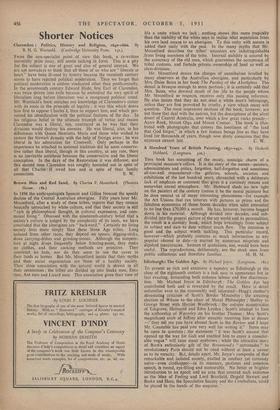Brown Men and Red Sand, By Charles P. Mountford. (Phoenix
House. 181.) IN 1898 the anthropologists Spencer and Gillen forecast the speedy decline of the Central Australian aborigine. Fifty years later Mr. Mountford, after a study of these tribes, reports that they remain basically untouched by white culture, and that their society is still "rich in philosophical thought, in cultural expression, and com- munal living." Obsessed with the nineteenth-century belief that a society's culture is judged by the complexity of its tools, we have 'concluded that the aborigines are "backward." Certainly no living :society lives more simply than these Stone Age tribes. Long I isolated from other races, they depend on spears, digging-sticks, stone carrying-dishes and grinding-stones. Although the tempera- ture at night drops frequently below freezing-point, they make no clothes, and their cooking methods are primitive. They construct no huts, nor do they seem to use the caves in their lands as homes. But Mr. Mountford insists that their myths and their social organisation are those of a healthy society. Their close association with the natural world is shown in all their ceremonies ; the tribes are divided up into Snake men, Emu men, Ant men and Lizard men. This association gives their view of
life a unity which we lack.; nothing shows this more tragically than the inability of the white man to realise what separation from his own land means to an aborigine. To this unity with nature is added their unity with the past. In the many myths that Mr. Mountford describes the tribes' ancestors are indistinguishable .from living members of the tribe. Internal stability is assured by the autocracy of the old men, which guarantees the acceptance of tribal customs, and forbids private ownership of land as well as class-divisions.
Mr. Mountford denies the charges of cannibalism levelled by many observers at the Australian aborigine, and particularly by Mrs. Daisy Bates in her book The Passing of the Aborigines. The denial is brusque enough to seem partisan ; it is certainly odd that Mrs. Bates, who devoted much of her life to the people whom Mr. Mountford so respects, receives only this passing reference. He also insists that they do not steal a white man's belongings, unless they are first provoked by cruelty, a view which many will question. The most impressive sections of the book, however, are not those that deal with the natives, but the descriptions of the silent desert of Central Australia, over which a few great rocks preside— Ayers Rock, Mount Olga and Mount Connor. The book is illus- trated with photographs that convey the loneliness of "the land that God forgot," in which a few human beings live as they have lived for thousands of years, though now dimly conscious that this





















































 Previous page
Previous page